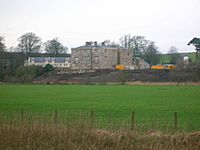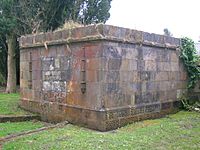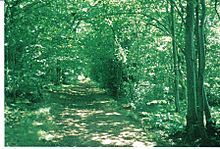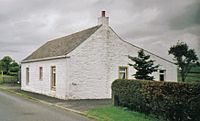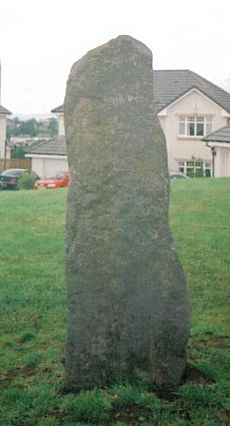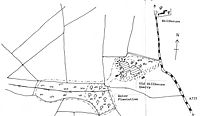Lands of Lainshaw facts for kids
Quick facts for kids Lainshaw House |
|
|---|---|
| Stewarton, East Ayrshire, Scotland GB |
|
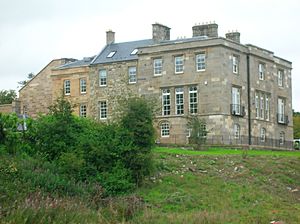
The restored Lainshaw House in 2007, showing the various construction phases.
|
|
| Coordinates | 55°40′30″N 4°31′48″W / 55.674929°N 4.529863°W |
| Site information | |
| Owner | Private |
| Open to the public |
No |
| Condition | Flats |
| Site history | |
| Built | Circa 1779 |
| Built by | Cunninghame |
| Materials | Stone |
The Lands of Lainshaw are located in Stewarton, East Ayrshire, Scotland. Lainshaw House is a historic mansion that sits proudly above the Annick Water. It is a "category B listed" building, meaning it's important for its history and architecture. Inside Lainshaw House, you can still find parts of the much older Lainshaw Castle. This shows how the building has changed over many years. In the past, people sometimes called it 'Langshaw' or 'Langschaw'. Some believe the original castle was on Law Mount, given to Godfrey de Ross in the 1100s.
Contents
Exploring the Lands of Lainshaw
Who Owned Lainshaw?
| What's in a Name? |
| The name Lainshaw comes from old Scottish words. Lang means long, and Shaw means a strip of woodland. So, Lainshaw means a long strip of trees. |
The lands of Lainshaw were very important. Scottish Kings often gave them as special gifts. The Stuarts (or Stewarts) were early owners. Later, Mary, Queen of Scots gave the lands to Mary Livingstone in 1565. She was one of her famous "four Marys."
One of the first records of Lainshaw is from 1450. King James II gave the land to Alexander Home of Holme. Other areas like Castleton and Robertland were also part of this gift. The land then passed to the Eglinton family. Sir Neil Montgomerie of Langshaw, from this family, was killed in 1547 due to a local dispute.
Over time, the Montgomerie family continued to own Lainshaw. In 1654, Neil Montgomerie and his son John sold their estates. They sold them to John of Cockilbie, another family member.
In 1767, James, the 9th Laird, passed away. His oldest sister, Elizabeth, inherited the estate. Elizabeth married Alexander Montgomerie-Cuninghame. Their daughter, Margaret Montgomerie, later married the famous writer James Boswell.
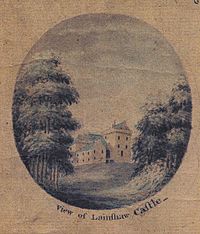
Their son, Sir Walter Montgomerie-Cuninghame, became the 10th Laird. He lost a lot of money during the American War of Independence. In 1779, William Cunninghame bought Lainshaw from Sir Walter. William was a "Tobacco Lord" who had made a fortune in America. He made many improvements to the estate.
William Cunninghame had many children. His third son, William Cunninghame, inherited Lainshaw in 1799. He moved into the house in 1804 and greatly changed its design. He was known for his strong religious beliefs. When he died in 1849, his younger half-brother, John Cuninghame, took over.
The House and Its Surroundings
The Cunninghame family owned Lainshaw House until 1947. Then, the local government bought it. It became a care home for older people. After a time, it became a ruin. But it was later fixed up and turned into several apartments.
In 1691, Lainshaw had eleven fireplaces. The surrounding lands had over sixty homes. Near the main entrance, there was a whale bone arch. It was made from bones found where the Annick Water and Glazert Water meet.
An estate map from 1779 shows a band of trees around the property. A carriage-way ran through these woods. This path connected to a "ha-ha" near a special spring. A "ha-ha" is a hidden ditch that acts as a fence. It keeps animals out without blocking the view. People were often surprised by them, which is how they got their name.
The old driveway to Lainshaw House also has a ha-ha. This one is near the home farm. The area around the ha-ha is very pretty. It is part of an old woodland.
-
A view of the abutment of the old carriageway bridge over the Annick Water near the Annick Road bridge at Stewarton.
Near the main entrance, there was a building called 'Castle-salt'. The reason for this name is not fully known. Salt houses were often found near large homes. They were used to store salted and preserved foods.
In 1779, the estate had many farms. These included Gilmill, Righead, and Irvinehill. The estate earned a lot of money from rent each year. The wall running from Freezeland to Law Mount was built by workers in the early 1800s.
Rare plants like Bird's Nest Orchids grew in the estate woodlands. These woods are sometimes called 'Wendy woods' today.
Old Chapels
Long ago, there were two chapels nearby. One was at Lainshaw and the other at Chapeltoun. The Lainshaw Chapel was dedicated to the Virgin Mary. After the Reformation, the chapel fell into ruin. No parts of it remain today.
The Lainshaw Sundial
Lainshaw once had a special sundial. It was a lectern style sundial. It had the Cuninghame family's coat of arms. The sundial is now at Hensol House near Castle Douglas. It might have been moved to Lainshaw in 1779.
Paths for Walking and Cycling
The Stewarton Woodland Action Trust has created many public paths. Some of these paths go through the old Lainshaw Estate. These paths are great for walking and cycling.
-
The Ha-ha at Lainshaw near the Chalybeate spring and the Chapelburn.
The Murder of the Earl of Eglinton
In 1586, a sad event happened at the Annick Ford in Stewarton. Hugh Montgomerie, the 4th Earl of Eglinton, was murdered. This happened because of a long-standing rivalry. The Montgomerie and Cunninghame families were competing for power. This event had a big impact across Ayrshire and beyond.
The Highland Host
In the 1600s, King Charles II sent Highland soldiers to Ayrshire. This was to stop certain religious gatherings. These soldiers were called the 'Highland Host'. They caused a lot of trouble. They took food and goods without paying. They also stole from people and destroyed property. They even used fire to force people to reveal where their money was hidden. This caused a lot of hardship for the local people.
Mineral Wells and Springs
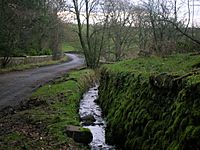
There is a special mineral spring near Stewarton called the Bloak Well. People found it because pigeons from Lainshaw House would gather there to drink. In 1833, Mr. Cunningham of Lainshaw built a nice house over the well. He believed the water had healing powers.
Another mineral spring is the Chapel Burn. It starts near Anderson Plantation. This spring is marked on old maps as a "chalybeate" spring. This means the water contains iron. People thought this type of water could cure many illnesses. They believed it could help with stomach problems and make people healthier. The main spring here is now covered. Its water flows into the burn.
There is also a cottage called Saltwell in Bloak. This well is thought to be under the building's floor. It was discovered because migrating birds, like swifts, flocked to it. The cottage was built between 1800 and 1850.
James Boswell's Connection
James Boswell, a famous writer, had a connection to Lainshaw. He was known for writing about his friend, Dr. Samuel Johnson. In 1769, James Boswell married his cousin, Margaret Montgomerie, at Lainshaw Castle. He had originally planned to marry another wealthy cousin. But he fell in love with Margaret, who had no money, and married her instead.
The room where they got married was above the room where the Earl of Eglinton was placed after he was murdered. This shows how Lainshaw House has been part of many important historical events.
Quick Facts About Lainshaw
- Jane Montgomerie was engaged to the 10th Earl of Eglinton. They never married because the Earl was murdered.
- During World War II, military training took place on the Annick Water near Lainshaw House. A dam was built to create a lake for this training.
- In 1920, William Henry Goff bought Lainshaw from the Cunninghame family.
- The church in Stewarton was once owned by the Cuninghames of Lainshaw.
- The town of Stewarton is named after Walter, a High Steward of Scotland in the 1100s.
- The Gallery of Modern Art (GOMA) in Glasgow was built in 1778. It was originally the home of William Cunninghame of Lainshaw, the wealthy tobacco lord.
- In the early 1600s, the area around Stewarton was very crowded with houses. People said it was more densely populated than some walled cities in Europe.
- In 1820, only six people in Stewarton Parish could vote. They were the owners of large estates like Lainshaw.
- The 'Stewarton Sickness' refers to a strong religious movement that began in 1625. It greatly influenced the people of Stewarton for many years.
- Lainshaw Mill
Lainshaw Mill was once famous for a large Rowan Tree growing out of its chimney. The mill stopped grinding corn in the 1930s. It was later destroyed by a fire. In the 1860s, William Eaglesham was the miller. The Lainshaw railway viaduct opened in 1868. Trains started running over it in 1871.
In 1797, a field near Magbie Hill was called 'Stone Field'. This might mean there was a standing stone there long ago. Coal pits were also found near Magbie Hill.
Stewarton is on an old main road. This road was completed in 1820. It connected Glasgow to Kilmarnock, Irvine, and Ayr.
Images for kids
-
A view of the abutment of the old carriageway bridge over the Annick Water near the Annick Road bridge at Stewarton.



